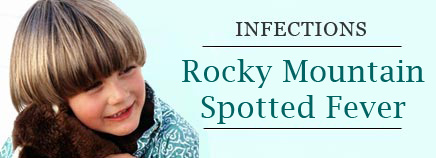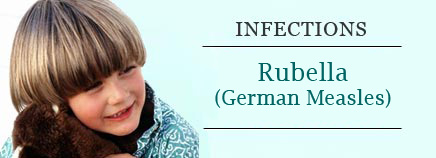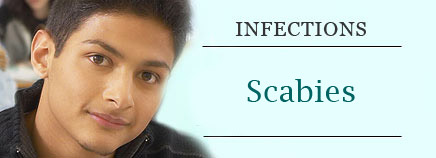Imagine this: your son shows you a raised patch of skin on his chest. He says it doesn’t really hurt, so you decide to see what happens and don’t call the doctor. About a week later, the patch is joined by lots of smaller, oval-shaped spots. What’s going on? Chances …
Rocky Mountain Spotted Fever
About RMSF Rocky Mountain spotted fever (RMSF) is a bacterial infection that’s transmitted to people by tick bites. It occurs most often in the spring and summer, during months when ticks are active — between April and early September. Although RMSF is most common in the southeastern part of the …
Roseola
About Roseola Roseola (also known as sixth disease, exanthem subitum, and roseola infantum) is a viral illness that most commonly affects young kids between 6 months and 2 years old. It is usually marked by several days of high fever, followed by a distinctive rash just as the fever breaks. How …
Rubella (German Measles)
About Rubella Rubella — commonly known as German measles or 3-day measles — is an infection that mostly affects the skin and lymph nodes. It is caused by the rubella virus (not the same virus that causes measles). Rubella spreads when people breathe in virus-infected fluid, such as the droplets …
Scabies
Scabies is a common skin infestation of tiny mites called Sarcoptes scabiei. The mites burrow into the top layer of human skin to lay their eggs, causing small itchy bumps and blisters. A child with scabies may have a bumpy red rash. Sometimes, raised wavy lines appear where the mites …
Scarlet Fever
Scarlet Fever Scarlet fever is caused by an infection with group A streptococcus bacteria (usually strep throat). The bacteria make a toxin (poison) that can cause the scarlet-colored rash that gives this illness its name. Not all streptococci bacteria make this toxin and not all kids are sensitive to it. Two …
Toxic Shock Syndrome
About Toxic Shock Syndrome Toxic shock syndrome (TSS) is a serious but uncommon infection caused by either Staphylococcus aureus (often called staph) and Streptococcus pyogenes (often called strep) bacteria, with most cases related to staph bacteria. TSS was originally linked to the use of tampons because the earliest cases, in …
Vitiligo
Whether fair, dark, or any shade in between, most kids have skin that is generally the same color all over their body. But this isn’t the case for those with vitiligo. Vitiligo is a loss of skin pigment, or color, that causes white spots or patches to appear on the …
Warts
About Warts Many of us have had a wart somewhere on our bodies at some time. Other than being a nuisance, most warts are harmless and go away on their own. Warts are skin infections caused by viruses of the human papillomavirus (HPV) family. They’re more common in kids than …
Chlamydia
About Chlamydia Chlamydia is a sexually transmitted disease (STD) caused by the bacteria Chlamydia trachomatis. When transmitted through sexual contact, the bacteria can infect the urinary and reproductive organs. The term chlamydia typically refers to the STD Chlamydia trachomatis, although two other types of this bacteria also can lead to illness: Chlamydia …










